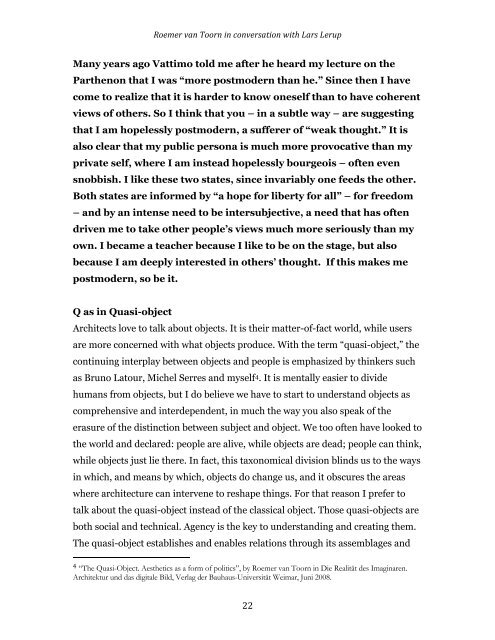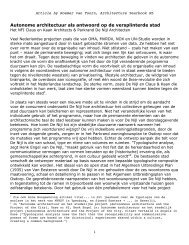ABCD Lars & Roemer
ABCD Lars & Roemer
ABCD Lars & Roemer
You also want an ePaper? Increase the reach of your titles
YUMPU automatically turns print PDFs into web optimized ePapers that Google loves.
<strong>Roemer</strong> van Toorn in conversation with <strong>Lars</strong> Lerup <br />
Many years ago Vattimo told me after he heard my lecture on the<br />
Parthenon that I was “more postmodern than he.” Since then I have<br />
come to realize that it is harder to know oneself than to have coherent<br />
views of others. So I think that you – in a subtle way – are suggesting<br />
that I am hopelessly postmodern, a sufferer of “weak thought.” It is<br />
also clear that my public persona is much more provocative than my<br />
private self, where I am instead hopelessly bourgeois – often even<br />
snobbish. I like these two states, since invariably one feeds the other.<br />
Both states are informed by “a hope for liberty for all” – for freedom<br />
– and by an intense need to be intersubjective, a need that has often<br />
driven me to take other people’s views much more seriously than my<br />
own. I became a teacher because I like to be on the stage, but also<br />
because I am deeply interested in others’ thought. If this makes me<br />
postmodern, so be it.<br />
Q as in Quasi-object<br />
Architects love to talk about objects. It is their matter-of-fact world, while users<br />
are more concerned with what objects produce. With the term “quasi-object,” the<br />
continuing interplay between objects and people is emphasized by thinkers such<br />
as Bruno Latour, Michel Serres and myself 4. It is mentally easier to divide<br />
humans from objects, but I do believe we have to start to understand objects as<br />
comprehensive and interdependent, in much the way you also speak of the<br />
erasure of the distinction between subject and object. We too often have looked to<br />
the world and declared: people are alive, while objects are dead; people can think,<br />
while objects just lie there. In fact, this taxonomical division blinds us to the ways<br />
in which, and means by which, objects do change us, and it obscures the areas<br />
where architecture can intervene to reshape things. For that reason I prefer to<br />
talk about the quasi-object instead of the classical object. Those quasi-objects are<br />
both social and technical. Agency is the key to understanding and creating them.<br />
The quasi-object establishes and enables relations through its assemblages and<br />
<br />
4 “The Quasi-Object. Aesthetics as a form of politics”, by <strong>Roemer</strong> van Toorn in Die Realität des Imaginaren.<br />
Architektur und das digitale Bild, Verlag der Bauhaus-Universität Weimar, Juni 2008. <br />
22






